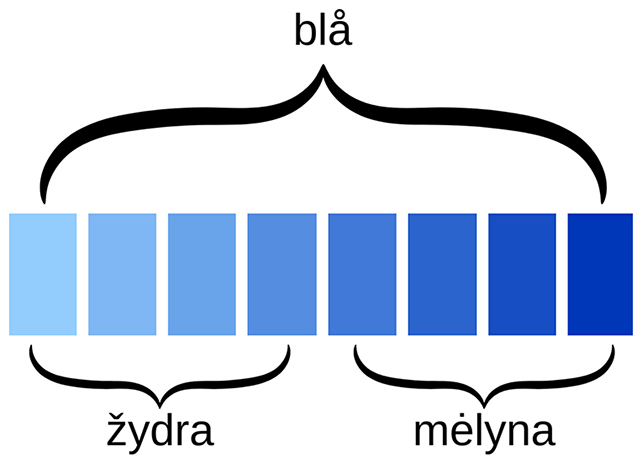ARTICLE AD
The time it takes for you to distinguish between similar shades and colors could depend on the words you use to describe them.
Research has repeatedly found speakers of languages with significantly different terms to distinguish between colors and shades – such as the Russian words siniy and goluboy for light blue and dark blue – are faster at distinguishing between those hues than languages that pile on adjectives.
Still, questions remain on whether this effect is malleable, and whether busying the brain with the right language might speed things up, or simply get in the way and slow the process down.
A new study from the Norwegian University of Science and Technology (NTNU) and the University of Oslo in Norway has found evidence that the language our brain uses to process our surroundings at any given moment affects how other cognitive activities build a sense of perception.
"This supports the idea that the language we use can affect how we perceive colors – and that this link is very dynamic and dependent on the activation in the brain," says Mila Vulchanova a linguist at NTNU.
For this study, a group of 106 volunteers consisting of Lithuanian speakers, Norwegian speakers, and Lithuanians proficient in Norwegian was put through a series of tests.
 There's one word in Norwegian for blue, but two in Lithuanian. (Akvilė Sinkevičiūtė)
There's one word in Norwegian for blue, but two in Lithuanian. (Akvilė Sinkevičiūtė)All three groups participated in two tests that timed how long it took to distinguish between pairs of chips of varying shades of blue. One test was conducted in relative silence, the other requiring them to memorize a series of eight digits. Those who were bilingual heard the numbers in Lithuanian first and then in Norwegian.
This was followed by a third test, where participants were timed in how long it took for them to identify a single shade of color.
Like Russian, Lithuanian has two words for blue (žydra for light blue and mėlyna for dark blue), where Norwegian has just one – blå. As previous studies had suggested, the bilingual volunteers could distinguish between color chips of different blue shades faster in Lithuanian than in Norwegian. Monolingual Lithuanians were also faster at noticing color differences than the monolingual Norwegians.
When the brain was kept busy remembering a string of numbers spoken in Lithuanian, bilingual speakers continued to have a speed advantage that didn't exist when they heard the numbers in Norwegian.
"The research reveals that the language being actively used by bilingual individuals can significantly affect their perception of color," says Akvilė Sinkevičiūtė, previously at NTNU and computer scientist now at Northeastern University London in the UK.
"The findings show that the language you use can shape how you perceive the world, right down to basic color perception."
While many of us may take color perception for granted, because our brains work everything out in a snap, being able to distinguish between colors is hugely important – from the red of a warning sign to the blackness on a moldy banana.
This color perception can be impacted in many ways, including through smell, and the results reported here add to what we know about language and cognition, and how the way we speak can train the brain.
"Our research and research done by others show that this is a two-way process," says Vulchanova. "This means that language can activate and influence cognitive categories, and vice versa, that cognitive mechanisms and categories influence language."
The research has been published in Language Learning.

 3 months ago
28
3 months ago
28 

